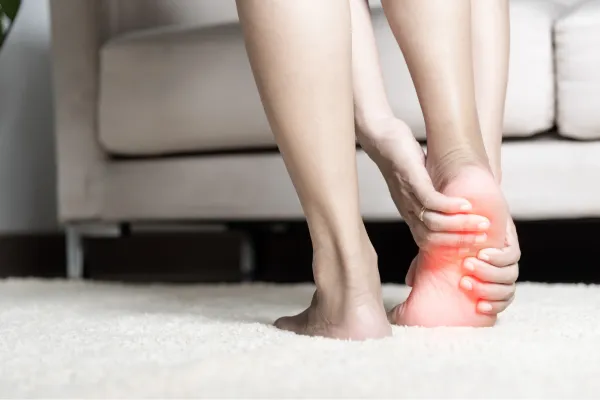
What is Plantar Fasciitis? Understanding the Causes and Symptoms
If you've ever experienced a sharp, stabbing pain in your heel, especially when taking your first steps in the morning, you may have dealt with plantar fasciitis. This common condition can cause significant discomfort and disrupt your daily activities. Fortunately, understanding its causes and symptoms can help you manage and even prevent it. In this post, we’ll dive into what plantar fasciitis is, why it happens, and how Oatley Physiotherapy Clinic can help you find relief.
What is Plantar Fasciitis?
Plantar fasciitis is the inflammation of the plantar fascia, a thick band of tissue that runs across the bottom of your foot, connecting your heel bone to your toes. This band helps support the arch of your foot and plays a crucial role in walking, running, and standing.
When the plantar fascia becomes irritated or inflamed, it can cause pain, especially in the heel area. The condition is most often felt as a sharp pain that occurs when you first stand up after sitting or lying down, although it can also be aggravated by prolonged standing or walking.
The Causes of Plantar Fasciitis
While the exact cause of plantar fasciitis can vary from person to person, several factors are commonly associated with its development. At Oatley Physiotherapy Clinic, we work with clients to identify and address the underlying causes of their discomfort, tailoring a treatment plan that targets the root cause of the problem.
Here are some common causes and risk factors of plantar fasciitis:
1. Overuse or Excessive Strain
One of the most common causes of plantar fasciitis is overuse or excessive strain on the plantar fascia. This can happen due to activities like running, jumping, or walking long distances, particularly on hard surfaces. People who suddenly increase their physical activity or who have not been active for a while may be more prone to developing the condition.
2. Foot Structure and Alignment
Flat feet, high arches, or abnormal gait patterns can contribute to excessive pressure on the plantar fascia, leading to inflammation and pain. If the arch of your foot collapses during walking or running, it can stretch and strain the fascia, leading to the development of plantar fasciitis.
3. Tight Calf Muscles and Achilles Tendon
Tightness in the calf muscles or Achilles tendon can affect the way your foot functions, increasing stress on the plantar fascia. When your calf muscles are tight, they can limit the range of motion in your foot and ankle, putting extra pressure on the plantar fascia as you walk.
4. Age and Occupation
Plantar fasciitis is more common in people between the ages of 40 and 60, though it can affect anyone at any age. Certain occupations that involve prolonged standing, walking, or physical activity, such as teaching, factory work, or retail, can increase the likelihood of developing plantar fasciitis.
5. Obesity
Excess weight can put added stress on your feet, particularly on the plantar fascia. Over time, this increased pressure can cause the tissue to stretch and become inflamed, leading to the painful symptoms associated with plantar fasciitis.
6. Inappropriate Footwear
Wearing shoes that lack adequate support or cushioning can contribute to plantar fasciitis. High heels, flip-flops, and shoes with little arch support can exacerbate foot issues and lead to strain on the plantar fascia. Proper footwear is crucial for maintaining foot health and preventing discomfort.
Symptoms of Plantar Fasciitis
The hallmark symptom of plantar fasciitis is pain in the heel, but other symptoms may accompany it. At Oatley Physiotherapy Clinic, we encourage individuals to seek help early when symptoms first appear to prevent further complications and discomfort. Here’s what to watch out for:
1. Heel Pain
Pain is typically felt in the bottom of the heel, although it can also occur along the arch of the foot. The pain is usually worst when you take your first steps after waking up or after long periods of sitting. As you move around, the pain may lessen but can return after standing or walking for extended periods.
2. Stiffness and Swelling
People with plantar fasciitis often experience stiffness and swelling in the affected foot. This can make walking uncomfortable and contribute to the feeling of tightness in the morning. The stiffness can improve as the foot loosens up throughout the day, but may still return after long periods of standing or walking.
3. Tenderness
The area around the heel may feel tender to the touch. You may notice pain when pressing on the bottom of your foot, especially near the heel.
4. Pain After Exercise
Unlike many other conditions, plantar fasciitis pain is typically worse after physical activity, not during it. After long runs, walks, or intense exercise, the plantar fascia can become inflamed, causing pain and discomfort.
How Physiotherapy Can Help with Plantar Fasciitis
At Oatley Physiotherapy Clinic, we offer a range of effective treatments that target the specific needs of those dealing with plantar fasciitis. A tailored physiotherapy program can help reduce pain, improve mobility, and prevent future flare-ups. Here’s how physiotherapy can help:
1. Stretching and Strengthening Exercises
Our physiotherapists guide clients through stretching and strengthening exercises that target the plantar fascia, calf muscles, and Achilles tendon. This helps improve flexibility, reduce tightness, and prevent further strain on the fascia.
2. Manual Therapy
Techniques such as massage and joint mobilisation can help release tightness in the foot, calf, and lower leg. Manual therapy can also improve circulation, reduce inflammation, and promote healing.
3. Custom Foot Orthotics
In some cases, custom foot orthotics may be recommended to help provide support and cushioning. These devices can correct alignment issues and help distribute pressure more evenly across the foot, relieving strain on the plantar fascia.
4. Education on Footwear
Proper footwear is essential for managing plantar fasciitis. Our physiotherapists can offer guidance on selecting shoes that provide the right support and cushioning, helping to reduce the pressure on the plantar fascia.
5. Taping and Dry Needling
We may use taping techniques to provide additional support to the foot during activities or while healing. Dry needling can also help to release tight muscle knots and reduce inflammation around the affected area.
Conclusion
If you’re experiencing heel pain or suspect you have plantar fasciitis, it’s essential to get a proper diagnosis and treatment plan. At Take Control Active Rehab we’re here to help you manage your symptoms and get you back on your feet.
Whether through targeted exercises, manual therapy, or other treatments, we can help you relieve the pain, improve foot function, and prevent future issues. If you’d like more information on how physiotherapy can treat plantar fasciitis, don’t hesitate to reach out to our team today!



